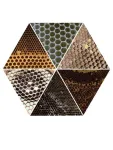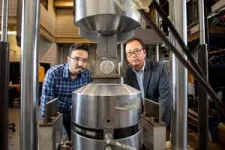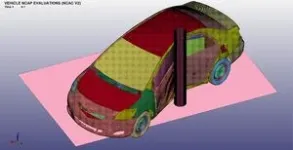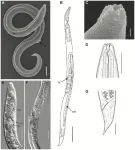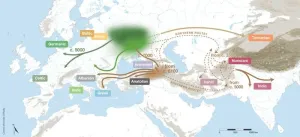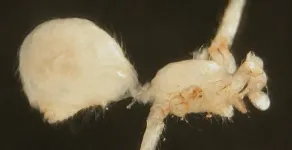(Press-News.org) At first glance, the hexagonal cells build by honey bees and social wasps may seem similar, but they are significantly different. Honey bees build using wax, whereas wasps use paper. Honey bees build their double-sided combs vertically, whereas wasps build single-sided comb horizontally (i.e., the opening of each cell faces downward).
Indeed, the hexagonal cells built by these two groups have independent evolutionary origins. Just like sharks and whales have similar body plans due to their watery environment, bees and wasps build hexagonal cells because the shape maximizes strength and storage area, while minimizing building materials.
But what happens when perfectly hexagonal cells cannot be built? Do bees and wasps fix their building problems in the same way?
In a subset of honey bee and wasp species, workers build two different sizes of hexagons. The smaller cells are used for rearing workers, and the larger cells are used for rearing reproductives; drones and queens. This difference in cell sizes creates an inherent architectural problem: how do you tile two differently-sized hexagons within a single sheet of comb?
To determine how different species solved the same architectural problem, the researchers needed nest images that included both worker and reproductive cells in the same comb.
First-author Dr. Michael L. Smith, Assistant Professor in the Department of Biological Sciences at Auburn University, and Affiliate Member of the Max Planck Institute for Animal Behavior, contacted researchers across the globe for potential images. They then used custom-built software to extract per-cell metrics from 22,745 individual cells.
In some species, like Metapolybia mesoamerica, worker and reproductive cells are the same size, so there was no architectural hurdle to overcome. In other species, like Apis andreniformis, reproductive cells are up to 2.7 times larger than worker cells, which creates a serious building problem – how to combine these wildly different hexagons in an efficient way?
Looking across 10 species, the researchers found that as the scale of the building problem increased (the size difference between worker and reproductive cells), workers began incorporating non-hexagonal cells. These irregular cells were mostly 5- and 7-sided, but they were consistently built in pairs, with the 5-sided cell built on the worker-side, followed by a 7-sided cell on the reproductive side. This pattern was seen in all the honey bee and wasp species that had a cell-size difference to overcome. For a group of insects renowned for their hexagonal cells, this alone was interesting, as it showed that they all rely on the same non-hexagonal configurations.
The researchers then built a mathematical model that would predict, based on the cell-size difference, how many non-hexagonal cells should be incorporated into the worker-to-reproductive transition. Surprisingly, some of the species were consistently performing better than expected. Upon closer investigation, the researchers saw that these species also incorporated intermediate-sized cells into the transition region. The intermediate-sized cells were still hexagonal, but they allowed the insects to “split the difference” and turn the cell-size transition into a series of smaller ones, which didn’t require non-hexagonal cells.
These same building tricks were adopted across all species of bees and wasps investigated. Despite being separated by over 179 million years of evolution, using different building materials, and independent origins of hexagonal cells, these species have all arrived at the exact same solution to this scalable architectural problem.
“Once we were able to plot out all the data, the results were striking – you could see how the bees and wasps used intermediate-sized cells to make a gradual change, but also how consistently the non-hexagonal cells were arranged in the comb” said Michael L. Smith.
This work has implications for how collective systems can build adaptive and resilient structures without centralized control. There is no single bee or wasp “architect” building the entire structure, instead, it is hundreds or even thousands of individuals contributing to the final product.
This work, titled “Honey bees and social wasps reach convergent architectural solutions to nest-building problems,” was published 27 July 2023 in the journal PLOS Biology.
This study was funded by the National Science Foundation, the German Research Foundation, a Packard Fellowship for Science and Engineering, and GETTYLABS.
This manuscript is published in PLOS Biology and is freely available at the following link: http://journals.plos.org/plosbiology/article?id=10.1371/journal.pbio.3002211
END
Bees and wasps independently invent the same architectural tricks
Insects use the same types of non-hexagonal cells to overcome building challenges
2023-07-27
ELSE PRESS RELEASES FROM THIS DATE:
Study finds strong support for easing Medicaid enrollment procedures
2023-07-27
During the COVID-19 pandemic, governments changed rules and procedures related to Medicaid enrollment. These changes decreased many of the burdens eligible people face when signing up for programs and contributed to a 30 percent increase in Medicaid enrollment. However, the end of public health emergency declarations brings an end to these pandemic policies, which many fear could lead to eligible people losing public health insurance simply because they are unable to fulfill administrative requirements such as accurately filling out and submitting forms, renewing their enrollment ...
MIND diet study shows 'short-term' impact on cognition
2023-07-27
New research shows the importance of long-term commitment to the MIND diet for reaping the greatest benefit to brain health.
“The benefits within the new study’s three-year clinical trial weren’t as impressive as we’ve seen with the MIND diet observational studies in the past, but there were improvements in cognition in the short-term, consistent with the longer-term observational data,” said lead study author Lisa Barnes, PhD, associate director of the Alzheimer’s Disease Research Center at RUSH.
Results from the study, published in The New England Journal of Medicine, showed that within a three-year period, there was no significant ...
Race/ethnicity isn't associated with unplanned hospitalizations after breast reconstruction
2023-07-27
July 27, 2023 – Race/ethnicity is not an independent predictor of hospital readmission in patients undergoing breast reconstruction surgery, reports a study in the August issue of Plastic and Reconstructive Surgery®, the official medical journal of the American Society of Plastic Surgeons (ASPS). The journal is published in the Lippincott portfolio by Wolters Kluwer.
Among patients who have unplanned hospitalizations after breast reconstruction, costs are substantially higher for Black or Hispanic patients, according to the new research by ASPS ...
Nematode resurrected from Siberian permafrost laid dormant for 46,000 years
2023-07-27
A soil nematode reanimated from Siberian permafrost had laid dormant for approximately 46,000 years, according to a study publishing July 27, 2023 in the open access journal PLOS Genetics by Anastasia Shatilovich at the Institute of Physicochemical and Biological Problems in Soil Science RAS in Russia, Vamshidhar Gade at the Max Planck Institute for Molecular Cell Biology and Genetics in Germany, and colleagues.
Some animals, such as tardigrades, rotifers, and nematodes, can survive harsh conditions by entering a dormant state known as “cryptobiosis”. Previously, nematode individuals were reanimated from samples collected from a fossilized burrow in silt deposits ...
New insights into the origin of the Indo-European languages
2023-07-27
For over two hundred years, the origin of the Indo-European languages has been disputed. Two main theories have recently dominated this debate: the ‘Steppe’ hypothesis, which proposes an origin in the Pontic-Caspian Steppe around 6000 years ago, and the ‘Anatolian’ or ‘farming’ hypothesis, suggesting an older origin tied to early agriculture around 9000 years ago. Previous phylogenetic analyses of Indo-European languages have come to conflicting conclusions about the age of the family, due to the combined effects of inaccuracies and inconsistencies in the datasets they used and limitations in the way that phylogenetic methods analyzed ...
Genome analysis of 46,000-year-old roundworm from Siberian permafrost reveals novel species
2023-07-27
Some organisms, such as tardigrades, rotifers, and nematodes, can survive harsh conditions by entering a dormant state known as “cryptobiosis.” In 2018, researchers from the Institute of Physicochemical and Biological Problems in Soil Science RAS in Russia found two roundworms (nematode) species in the Siberian Permafrost. Radiocarbon dating indicated that the nematode individuals have remained in cryptobiosis since the late Pleistocene, about 46,000 years ago. Researchers from the Max Planck Institute of Molecular Cell Biology and Genetics (MPI-CBG) in ...
Tau-regulating protein identified as a promising target for developing Alzheimer’s disease treatment
2023-07-27
PHILADELPHIA – A gene encoding a protein linked to tau production—tripartite motif protein 11 (TRIM11)—was found to suppress deterioration in small animal models of neurodegenerative diseases similar to Alzheimer’s disease (AD), while improving cognitive and motor abilities, according to new research from the Perelman School of Medicine at the University of Pennsylvania. Additionally, TRIM11 was identified as playing a key role in removing the protein tangles that cause neurodegenerative diseases, like AD. The findings are published today in Science. ...
A unified theory of the lexicon and the mind: Researchers find common cognitive foundation for child language development and language evolution
2023-07-27
Cognitive and computer scientists at the University of Toronto, Universitat Pompeu Fabra and the Catalan Institution for Research and Advanced Studies have found child language development and the historical evolution of the world’s languages share a common cognitive foundation—a core knowledge base where patterns of children’s language innovation can predict patterns of language evolution, and vice versa.
Published today in Science, the paper is a first-of-its-kind step toward a unified theory of the lexicon and the mind examined across timescales. The result may also help predict how a word’s meaning may change ...
Exposure to like-minded sources on Facebook is prevalent but did not increase polarization during the 2020 U.S. election
2023-07-27
People often debate whether social media creates "echo chambers" by showing users content that matches their politics and in turn increases polarization. A new study published today in the journal Nature reports that reducing Facebook users' exposure to content from politically "like-minded" sources had no measurable effect on their political beliefs or attitudes during the 2020 U.S. presidential election.
The findings are part of a broader research project examining the role of ...
From Down Under to Underground: surprising daddy long-legs spiders discovered in Australia and Réunion
2023-07-27
Australia’s rich and diverse fauna never fails to surprise us, as a new spider species has been documented from the continent.
The novel species, a blind daddy long-legs, was found in boreholes in the arid Pilbara of Western Australia. It is the first cave-adapted daddy long-legs spider reported from the continent, with other blind species of its genus so far only found in Thailand, Laos, and Vietnam.
“It represents a subfamily that was previously thought to be restricted to the tropical north and east of the continent,” says Bernhard Huber, one of the authors of a recent study published ...
LAST 30 PRESS RELEASES:
Structural findings reveal how distinct GPCR ligands create different levels of activation
Anything-goes “anyons” may be at the root of surprising quantum experiments
UC review: Maximizing workplace opportunity for veterans
From generation to complex control: Metasurfaces make perfect vortex beams "within reach"
Thin-film lithium niobate-based detector: recent advances and perspectives
Exploring why some people may tend to persistently make bad choices
How cells balance their protein levels
Nirsevimab vs RSVpreF vaccine for RSV–related hospitalization in newborns
Effectiveness and impact of maternal RSV immunization and nirsevimab on medically attended RSV in US children
AI gives scientists a boost, but at the cost of too many mediocre papers
Next-generation vision model maps tree growth at sub-meter precision
Genes aren’t destiny for inherited blindness, study shows
MIT study: High-fat diets make liver cells more likely to become cancerous
Exposure to multiple fine particulate matter components and incident depression in the US Medicare population
Risk of burdensome health care spending over time in the US
Nirsevimab against hospitalizations and emergency department visits for lower respiratory tract infection in infants
New microfluidics technology enables highly uniform DNA condensate formation
A new strategy for immune tolerance
Super Mario Bros. help fight burnout: New study links classic games to boosted happiness
Deepest gas hydrate cold seep ever discovered in the arctic: International research team unveils Freya Hydrate Mounds at 3,640 m depth.
Integrating light and structure: Smarter mapping for fragile wetland ecosystems
ACA-SIM: A robust way to decode satellite signals over complex waters
Probiotics can restore gut microbiome in breastfed infants
AI could help predict nutrition risks in ICU patients, study finds
Federal EITC has unexpected result, researchers say – it decreases domestic violence
Researchers identify gene that calms the mind and improves attention in mice
Artificial metabolism turns waste CO2 into useful chemicals
Ancient sea anemone sheds light on animal cell type evolution
Begging gene leads to drone food
How climate policies that incentivize and penalize can drive the clean energy transition
[Press-News.org] Bees and wasps independently invent the same architectural tricksInsects use the same types of non-hexagonal cells to overcome building challenges
